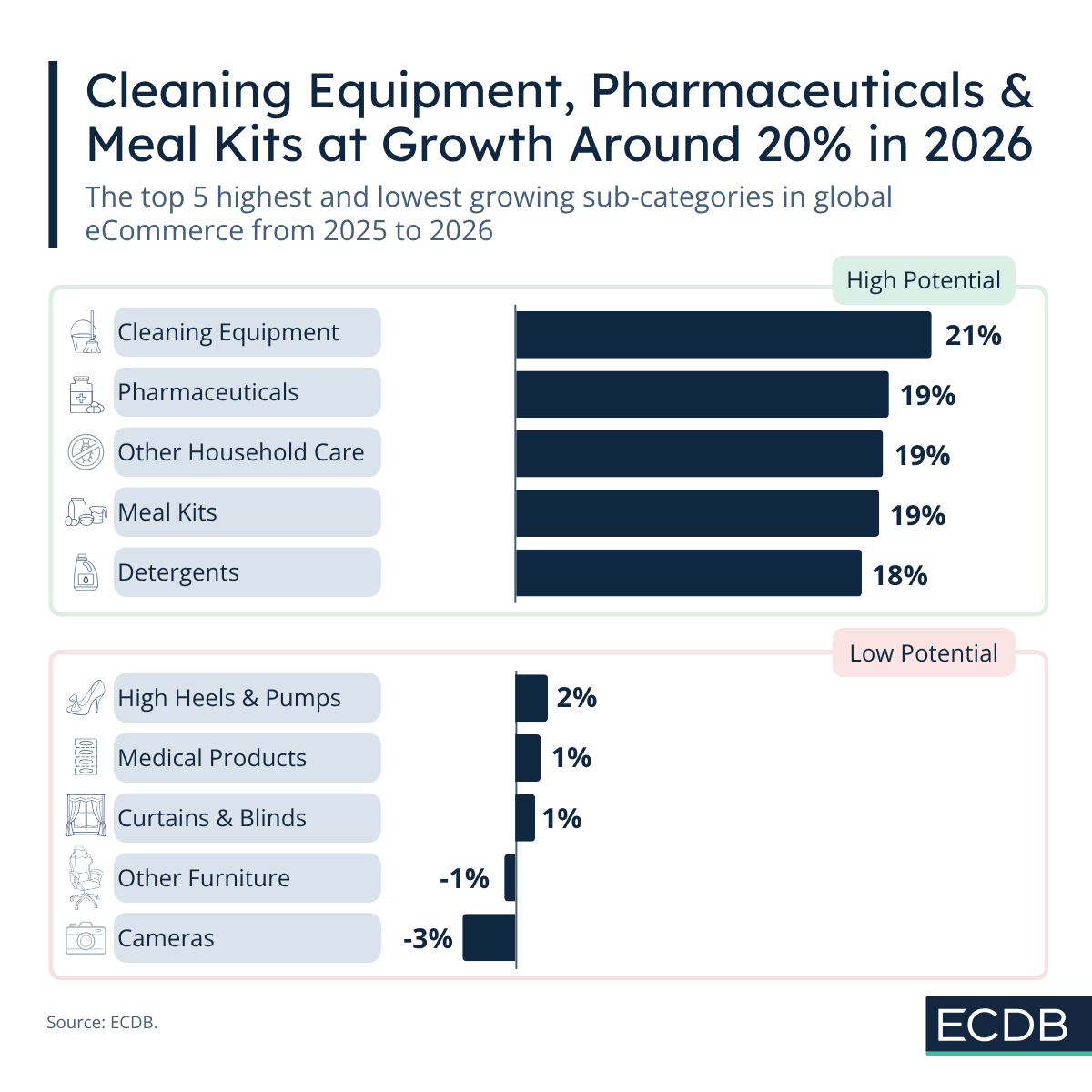As the year comes to a close, it is time to look ahead to 2026. A prospective estimate of category performance shows that, worldwide, Grocery is the fastest-growing category with significant potential for online revenue growth.
But what happens when we drill down into more granular subcategories than is usual? Which subcategories will see a boost in the coming years while others fall behind?
There are clear winners and losers, so let’s see who they are.
Sub-Category Winners in 2026 Highlight Practicality
The top five product categories all revolve around a growth rate of 20% in 2025/26. They reflect eCommerce trends and hint at dominant consumer behavior patterns worth examining.
We’ll discuss three of these patterns here. The first one encompasses bargains in everyday life, namely saving on recurring expenses like Cleaning Equipment.
1. Cleaning Equipment, Other Household Care (Pest control products), Detergents
One of the major advantages of online shopping is the ability to effectively compare prices. Since online retailers don't have the same overhead costs as physical stores, everyday household goods are usually cheaper.
This trend is particularly evident in Chinese eCommerce, where kwaixiaodian.com, pinduoduo.com, douyin.com, and tmall.com lead in Household Care and Cleaning Equipment revenue. These sites offer perks like group buying, where social groups of shoppers purchase products in bulk to receive additional discounts.
Although the rest of the world is not as familiar with group buying, it benefits from shopping days and discount events. Many shoppers stock up on everyday products during these events, including Cleaning Equipment and the likes.
2. Pharmaceuticals
Pharmaceuticals eCommerce is currently experiencing a global surge. The global online share of pharmaceuticals is expected to approach 50% by 2029. A variety of factors contribute to the heyday of pharmaceuticals, which are expected to grow at a rate of 19% in 2026.
Pharmaceuticals include both OTC (over-the-counter) medicines and prescription drugs. OTC medicines are easily distributed because they are not subject to regulatory restrictions. In contrast, prescription drugs require a legal framework and administrative procedures to ensure the safe delivery of prescription medicines to the authorized user.
Since the pandemic, global regulations have become more open to the distribution of prescription drugs. In many cases, the benefits outweigh the risks: easier distribution means better availability and competitive pricing.
Pharmaceuticals, especially prescription drugs, are highly valuable and sought after by consumers with or without medical clearance. It is this very value that contributes to the rising share Pharmaceuticals take on in the Health Care category. As regulations in different countries change in favor of their distribution, pharmaceutical sales will become even more important for eCommerce.
3. Meal Kits
As a sub-category of Grocery in the Food section, Meal Kits are expected to grow by 19% in revenue from 2025 to 2026. Meal kits provide all the ingredients and recipes needed to prepare a complete meal.
Examples of meal kit providers would be hellofresh.com, hungryroot.com, purplecarrot.com, as well as freshippo.com in China.
Meal kit providers offer consumers a way to save time and resources by providing convenient and varied products for health-conscious users to prepare their own meals. The market has grown significantly in recent years, with new trends emerging as more providers enter the scene.
Product Types That Lack Usability Are Category Losers in 2026
At the other end of the spectrum are the product categories with very low to negative growth from 2025 to 2026. The growth decliners on this list represent categories that are not appealing to consumers due to factors such as unsuitability for eCommerce channels and temporary aspects.
1. High Heels & Pumps
Belonging to the broader category of Footwear, High Heels & Pumps are expected to grow at a rate of 2% from 2025 to 2026. This is due to the category's general unsuitability for online shopping. (Footwear is set at a growth rate of 5.5% in 2026.)
Despite novel technology like VR and AR, some items are best bought physically to try on products and check out their fit in person. Because of cost and sustainability aspects, major online stores now disincentivize buying multiple sizes of the same product, which is why some product categories suffer from these measures.
2. Medical Products
Other than Pharmaceuticals, which also fall under Health Care, Medical Products are expected to grow only by 1% from 2025 to 2026. Medical Products include Family Planning, Medical Supplies like mobility aids and orthopedic support and Other Medical Products like first-aid supplies and medical equipment.
The current low performance of medical products is due to post-pandemic readjustment. Since the category grew more than usual in 2020 and 2021, subsequent years are seeing a readjustment reflecting lower demand for eCommerce in these product categories, as they are purchased infrequently.
3. Curtains & Blinds, Other Furniture
In general, bulky products are less suitable for online shopping, as consumers may find it harder to evaluate and commit to a purchase without seeing the item in person. On top of that, there are the added challenges of delivery and returns.
Curtains & Blinds, as well as Other Furniture (which includes gaming furniture like gaming chairs or desks) are both categories that consumers buy only occasionally and that are harder to evaluate online than in-store. The respective growth rates of 1% for Curtains & Blinds and -1% for Other Furniture reflect these difficulties.
4. Cameras
A third-level sub-category of Consumer Electronics, Cameras perform the worst year-on-year in 2026, with a degrowth rate of -3%. While Consumer Electronics in general perform better, with 6.8% growth in 2025/26, Cameras lag in eCommerce.
The reasons for this lag do not lie in the nature of camera deliverability; rather, they relate to consumer behavior and general market factors. First and foremost, this refers to usability.
Since most consumers now have a high-quality camera built into their smartphones (with a growth rate of 7.1%), standalone cameras have become primarily used by hobby photographers and analog enthusiasts. Moreover, cameras tend to be infrequent purchases that often require expert advice to ensure the product matches individual needs and expectations. They are therefore suited to physical retail sales.
The outlook for the growth of product categories reflects general consumer trends. Categories that combine convenience, accessibility, and value generally see higher demand through online channels. However, products that rely heavily on physical interaction, personalized consultation, or infrequent replacement cycles see slower or even negative growth.










